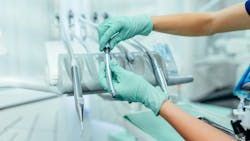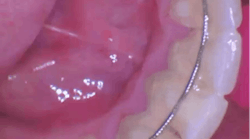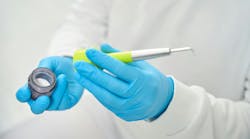Implant maintenance: Dental hygienists’ use of air polishers with glycine, erythritol, and sodium bicarbonate
What you'll learn in this article
- Why air polishing is considered the gold standard for safe and effective implant biofilm removal.
- How different air polishing powders impact implant surfaces and influence long-term peri-implant health.
- Insights from a 2024 survey on hygienists’ air polisher use and implant maintenance training trends.
- Efficacy comparisons between glycine, erythritol, and sodium bicarbonate powders in clinical practice.
- How education, equipment choices, and team collaboration affect adoption of implant-safe air polishing methods.
The use of air polishing has been presented as the gold standard for biofilm removal with implant maintenance. Traditional methods of debriding implant surfaces, such as hand scaling with metal instruments or polishing with abrasive polish, may cause surface changes, increase roughness, and biofilm adhesion.1
Air polishing has emerged as a less invasive alternative that uses fine abrasive powders and pressurized air to remove biofilm without causing significant damage to the implant surface.2 Different types of abrasive powders are used in air polishing, including glycine, sodium bicarbonate, and erythritol. Each powder has unique properties that may affect the surface texture and biocompatibility of the dental implant surface.3
Here I’ll explore dental hygienists' knowledge for using air polishers on dental implants.
Formal implant maintenance training, past and present
The dental implant industry has witnessed tremendous growth in recent years, driven by technological advancements that enhance precision, affordability, and accessibility. In the US, the dental implant market was valued at $4.43 billion in 2023 and is projected to reach $5.89 billion by 2029, growing at a 4.86% CAGR.4 That’s five million dental implants projected to be placed per year.
Study implementation
In 2024, I surveyed 413 dental hygienists with formal implant education. I sent a digital survey to hygienists through email, social media, and during continuing education events that I taught across diverse US regions. The survey represented dental hygienists in the Northeast, South, West Coast, and Midwest.
These professionals reported receiving their formal dental hygiene training between 1959 and 2024. Participants represented varied practice settings, including general practices and periodontal offices. Participants reported seeing a variety of patient volumes. They were asked to share their experiences with air polish and air abrasive methods for implant maintenance.
Education for implant maintenance is on the rise. Of the 604 who completed the 2024 survey, 42.6% reported lacking implant maintenance training, and 57.4% reported receiving formal implant maintenance training.
The breakdown of survey results
- Air polish/air flow devices: Of the 413 who responded to the survey about air polishing use, 25% (103 hygienists) reported using air polishers for professional biofilm removal on dental implants, and 75% (310 hygienists) reported not using air polishers on dental implants. When the 103 air polisher users were asked about their effectiveness in the removal of biofilm, a compelling 99% (102 respondents) found use of air polishing effective in removing biofilm around dental implants. One person reported use of an air polisher as ineffective.
Comparison with historical data
The inspiration for this 2024 survey was to compare data and demonstrate the growth of trends for implant maintenance. In a 2020 survey conducted by Ivy Zellmer, a reported 5% (82 of the 1,646 hygienists who responded) reported using air polishers. 71% (58 of the 82 respondents) of those who used air polishers reported finding the use of air polishers effective.5
What powder agent was used by the 413 air polisher users?
Sodium bicarbonate/baking soda: 22% (90 hygienists) reported using sodium bicarbonate as an air abrasive powder agent. Of those 90, 97% (87 respondents) reported finding sodium bicarbonate effective in removing biofilm, and 3% (three respondents) found it not effective in removing biofilm.
Erythritol: 31% (128 hygienists) reported using erythritol as the air-flow agent on dental implants. Of those 128 respondents, 98% (125) found use of erythritol to be effective, and 2% (three respondents) found it ineffective,
Glycine: 36% (149 hygienists) reported use of low abrasive powder glycine, the most popular air abrasive here. Of the 149, 97% (145) reported use of glycine to be effective, and 3% (four) found it ineffective in removing biofilm.
Benefits of agents chosen
Maintaining the smoothness of the implant abutment surface is important as increased roughness can facilitate bacterial colonization and biofilm formation, leading to a higher risk of peri-implant complications.6
Glycine and erythritol are fine, low-abrasive powders that have been shown to effectively remove biofilm without significantly altering the implant surface roughness.7 In contrast, sodium bicarbonate, a coarser abrasive, may cause surface alterations that increase roughness and potentially enhance bacterial adhesion.8
In 2024, Sah et. al. compared the effect of 20-second use of glycin, erythritol, and sodium bicarbonate on dental implant abutments.6 The air polisher pressure used 60 psi and a nozzle distance of 5 mm. Results revealed that the implant abutment’s surface roughness changed very little after air polishing with erythritol and glycine powders.
However, sodium bicarbonate powder dramatically increased surface roughness. Concerns here are that this increased roughness might raise the possibility of biofilm formation and affect the long-term success of the implants.
Prevalence of the use of sodium bicarbonate
The variety of products used can be related to the length of time air polishers have been on the market. The original Dentsply Prophy Jet, featuring sodium bicarbonate, was introduced to the dental profession in the late 1970s.9
Simply put, the baking soda prophy jet has been on the market for consumer purchase for many years longer than air polishing devices that are designed to use the implant-safe agents of erythritol and glycine. These are large ticket items. Air polishers are like cars; they’re a significant investment and will be used for years, as long as they’re working or until the office wants an upgrade.
Benefits of erythritol and glycine
Erythritol air polishing showed promising results for professional oral hygiene in implant-supported restorations and is effective and safe for removing biofilm from titanium dental implants.10 Erythritol air polishing promotes a favorable biological response without causing significant damage to the implant surface or peri-implant tissues.
Erythritol is an artificial sweetener and food additive. It’s a chemically neutral, nontoxic, water-soluble polyol. It has a small particle size, has been reported to lower the counts of P. gingivalis, and there is no significant damage to soft or hard tissue after using erythritol powder.
Glycine is an amino acid, nontoxic, biocompatible organic salt crystal. It has slow solubility in water and is 80% less abrasive than NaHCO₃. The particle size glycine powder ranges 45–60 µm. Glycine produces less soft tissue damage. Glycine powder demonstrated a reduction in probing pocket depth (PPD) and bleeding on probing (BOP) in 12-month studies.11 Rarely have emphysemas been reported as an adverse reaction.11,12
To conclude
The dental implant industry is rapidly evolving, with advancements in air polishing and safe air abrasive agents enhancing patient care. Adoption can be hindered by a lack of communication between surgical, restorative, and hygiene teams.
Often, those purchasing equipment may not attend the same training sessions as the dental hygiene team, which results in missed opportunities to collectively learn about and implement safe and effective implant maintenance protocols.
My 2024 survey reveals a positive shift—dental hygienists are increasingly embracing air polishing as part of their implant maintenance routine. Education and access to updated techniques have played a significant role in promoting better care practices and aligning the efforts of dental teams.
References
- Schwarz F, Rothamel D, Sculean A, et al. Effects of an Er:YAG laser and the Vektor ultrasonic system on the biocompatibility of titanium implants in cultures in human osteoblast-like cells. Clin Oral Implants Res. 2003;14:784. doi:10.1046/j.0905-7161.2003.00954.x
- Schwarz F, Derks J, Monje A, Wang HL. Peri-implantitis. J Clin Periodontol. 2018;45:S246. doi:10.1111/jcpe.12954
- Sah N, Bamusa B, Mehrotra N, Pradhan A, Mishra S, Goyal S. Effect of air polishing on surface roughness in implant abutments. Bioinformation. 2024;5;20(11):1667-1670. doi:10.6026/9732063002001667
- Dental implants market outlook, 2024-2029: demand for non-premium implants is growing as more patients seek affordable solutions for tooth replacement. Globe Newswire. January 3, 2025. https://www.globenewswire.com/news-release/2025/01/03/3003868/28124/en/Dental-Implants-Market-Outlook-2024-2029-Demand-for-Non-premium-Dental-Implants-is-Growing-as-More-Patients-Seek-Affordable-Solutions-for-Tooth-Replacement.html
- Zellmer IH, Couch ET, Berens L, Curtis DA. Dental hygienists’ knowledge regarding dental implant maintenance care: a national survey. J Dent Hyg. 2020;94(6):6-15.
- Sah N, Bamusa B, Mehrotra N, Pradhan A, Mishra S, Goyal S. Effect of air polishing on surface roughness in implant abutments. Bioinformation. 2024;5;20(11):1667-1670. doi:10.6026/9732063002001667
- Moëne R, Décaillet F, Andersen E, Mombelli A. Subgingival plaque removal using a new air-polishing device. J Periodontol. 2010;81(1):79-88. doi:10.1902/jop.2009.090394
- Müller N, Moëne R, Cancela JA, Mombelli A. Subgingival air-polishing with erythritol during periodontal maintenance: randomized clinical trial of twelve months. J Clin Periodontol. 2014;41(9):883-889. doi:10.1111/jcpe
- Graumann SJ, Sensat ML, Stoltenberg JL. Air polishing: a review of current literature. J Dent Hyg. 2013;87(4):173-180;
- Delucchi F, Ingegnieros L, Pesce P, et al. Efficacy and safety of erythritol air-polishing in implant dentistry: a systematic review. Int J Dent Hyg. 2025;23(1):44-62. doi:10.1111/idh.12836
- Shrivastava D, Natoli V, Srivastava KC, et al. Novel approach to dental biofilm management through guided biofilm therapy (GBT): a review. Microorganisms. 2021;9(9):1966. doi:10.3390/microorganisms9091966
- Munro IC, Berndt WO, Borzelleca JF, et al. Erythritol: an interpretive summary of biochemical, metabolic, toxicological and clinical data. Food Chem Toxicol. 1998;36:1139-1174. doi:10.1016/S0278-6915(98)00091-X
About the Author
Lynn Pencek, MS, RDH
Lynn Pencek, MS, RDH, has a unique balance of industry knowledge and clinical experience. As a member of the Nobel Biocare team, she helped dental implant teams develop efficient patient care workflows. As a dental hygienist, Lynn wanted to unravel the common questions and misunderstandings dental hygienists have about implant care and maintenance. She is the founder of Practice at Your Best, Learn more at practiceatyourbest.com or contact her at [email protected] .


